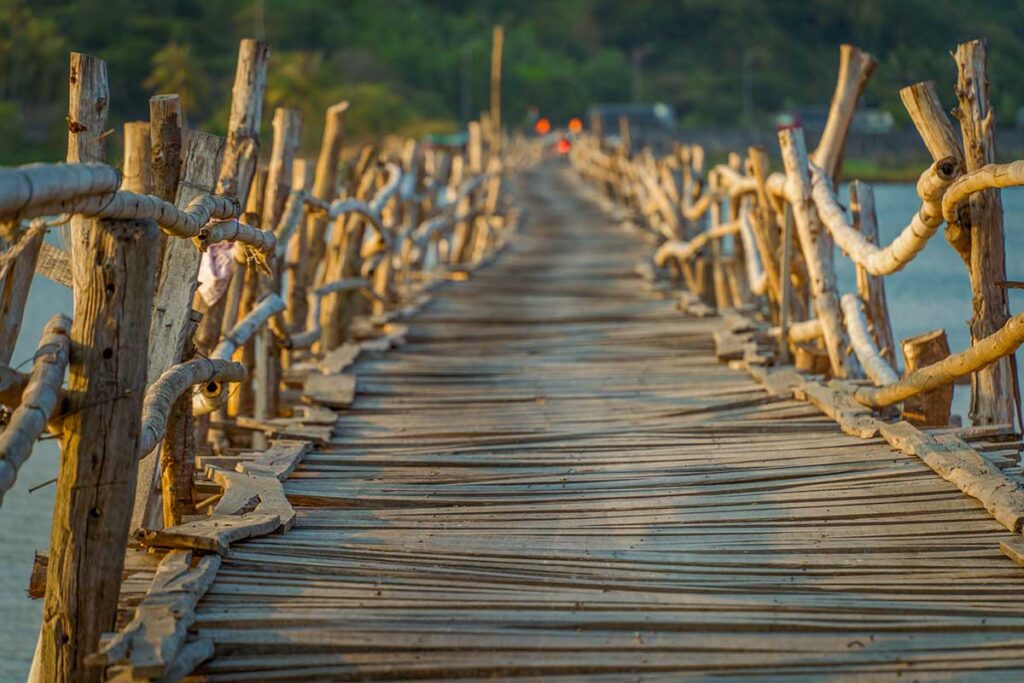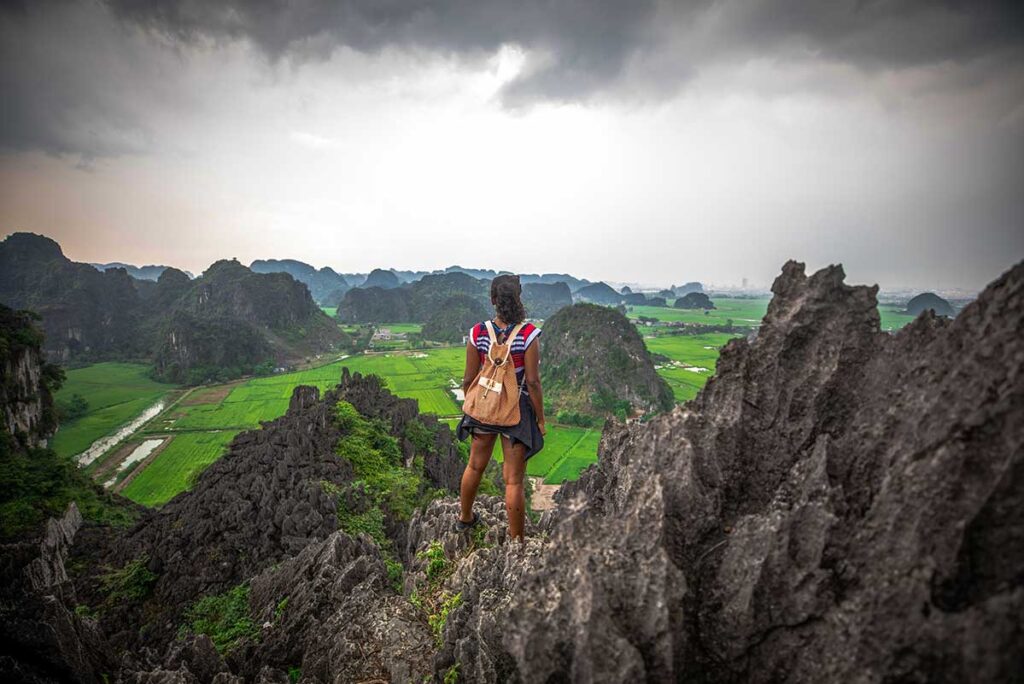What is Ong Cop Wooden Bridge?
A shortcut over the Binh Ba (Phu Ngan) River
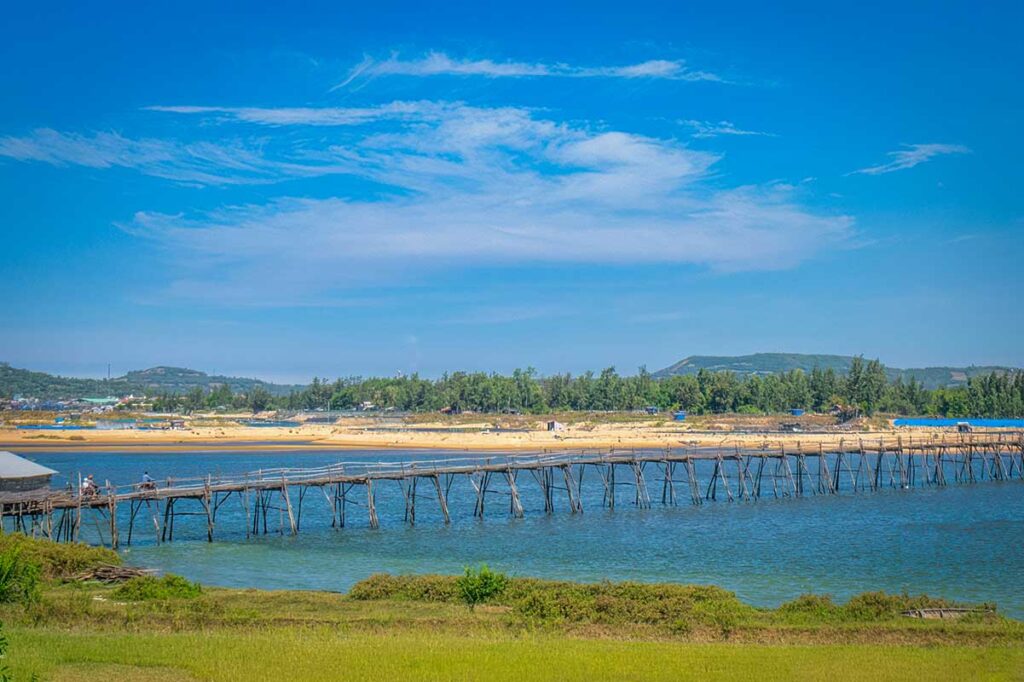
Ong Cop Wooden Bridge stretches across the Binh Ba River, also called the Phu Ngan, in northern Phu Yen. It links the rural commune of An Ninh Tay in Tuy An District with Xuan Dai Ward in Song Cau. For local people, this isn’t just a quirky landmark—it’s a lifeline. The bridge saves about 10 kilometers of travel compared to taking the highway or detouring by boat, making daily trips for school, markets, and work much quicker.
History, materials & the name “Ong Cop”
The bridge was first built in 1998 at a time when villagers needed a direct connection between communities on opposite sides of the river. Since then, it has been maintained by local households, who collect tolls and use the money to replace broken planks and repair storm damage. At nearly 800 meters in length and around 1.5–1.8 meters wide, it holds the record as Vietnam’s longest wooden bridge.

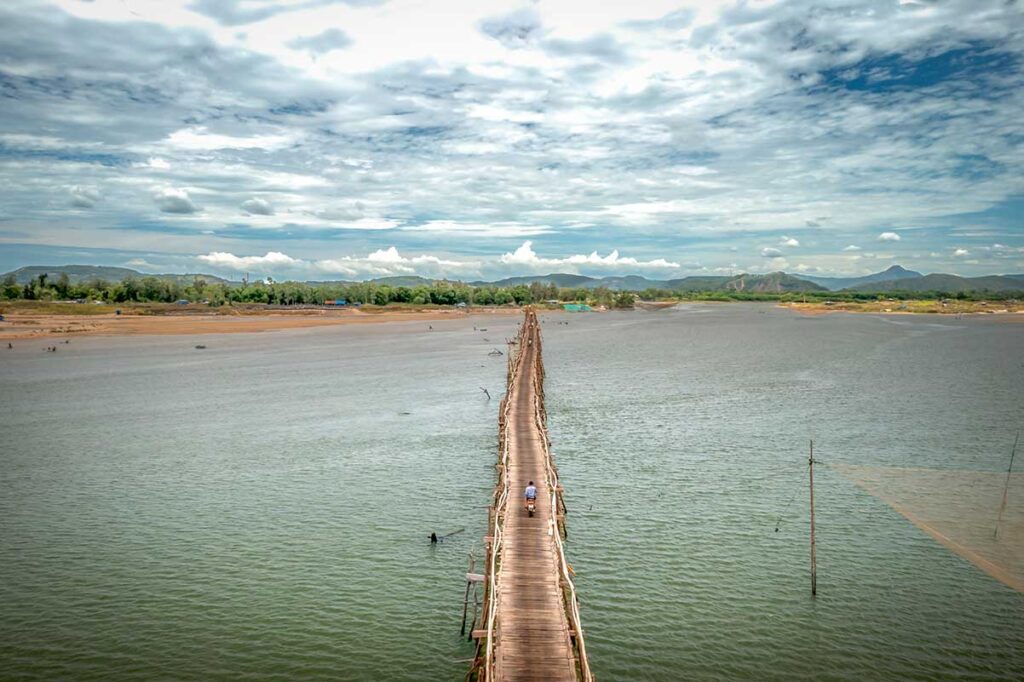
The construction is straightforward but clever: planks of casuarina and eucalyptus form the surface, with bamboo used for railings and extra reinforcement. Spare wooden boards are often kept at the ready so damaged sections can be swapped out quickly.

The name “Ong Cop” translates to “Mr. Tiger.” According to a local legend, a tigress once sought help from a midwife in the area to deliver her cubs. Out of gratitude, the tiger later returned with gifts and continued to visit her grave after she passed away. A shrine was built to honor this loyalty, and the nearby bridge took its name from the story.
The experience of riding or walking the bridge
Crossing Ong Cop Wooden Bridge is less about ticking off a major attraction and more about enjoying a rustic, very local experience. You’ll probably spend 20–40 minutes here—enough time to walk or ride across, take some photos, and soak in the scenery. It’s not the kind of place where you linger for hours, but as part of a coastal loop it makes for a memorable stop.
1. What to expect & how much time you need
This is a simple stop focused on the crossing itself and the views over the water. Most people walk or ride across once, take a few photos, and move on. Think of it as a scenic shortcut and photo spot rather than a standalone attraction.
2. Who can cross & where to park (no cars on the bridge)

Only pedestrians, bicycles, and motorbikes are allowed on the bridge—cars cannot drive across.

If you come by car, parking isn’t an issue. You can access the bridge from both sides, but the north side is the most convenient as it connects directly to National Highway 1. There’s a small café with free parking for guests — just stop for a coffee and combine it with a short walk across the bridge.
3. Toll fees (carry small cash)
Crossing isn’t free. Expect to pay a small toll:
- 1,000 VND on foot
- 2,000 VND for bicycles
- 3,000 VND for motorbikes
- 5,000 VND for motorbikes carrying goods.
In reality, the fee sometimes varies slightly, but it’s always pocket change—have small bills ready.
4. Walking across: the feel underfoot
On foot, the bridge feels long but manageable—around 800 meters end to end. The wooden planks creak and rattle, and you’ll often need to step aside for passing motorbikes. If you’ve arrived by car, this is how you’ll experience it: a slow walk across with plenty of time to take in the views. Don’t expect a smooth stroll—it’s uneven, but that’s part of the character.
5. Riding a motorbike across: narrow & shaky but memorable

Riding across is the classic way to experience the bridge. It’s only wide enough for two motorbikes to pass slowly, so you’ll need to ride single file and yield when needed. The surface can be bumpy with loose planks, so keep your speed low. If you’re not confident handling a motorbike, it’s better to walk—locals make it look easy, but the wobbly feel can be intimidating.
6. Cycling
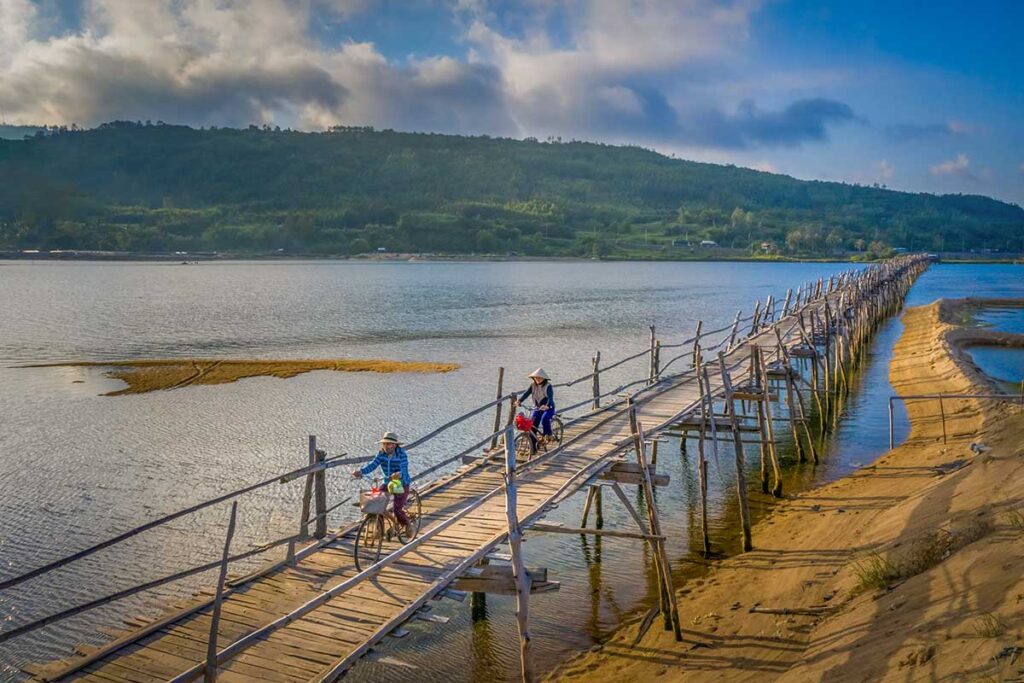
Cycling is possible, but unless you’re already touring the area by bike, it’s not common. If you do cycle, be alert for gaps between planks and constant motorbike traffic.
7. Safety & etiquette on a working bridge
This isn’t just a tourist spot—it’s a daily road for locals. Don’t block traffic while taking photos, step aside when motorbikes approach, and keep children close. If you detour to the nearby Mr. Cop shrine, dress modestly. And as always, carry your trash out—the bridge is fragile and basic, so treat it with care.
8. Best times for photos
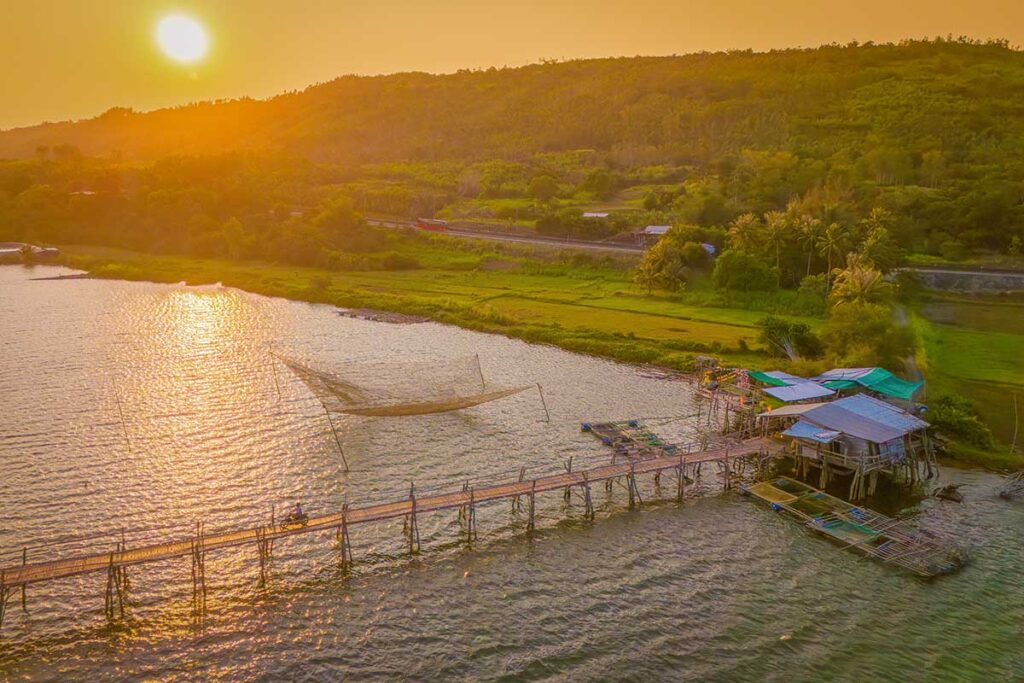
The bridge is most atmospheric at sunrise or sunset, when the light is softer and the water reflects the colors of the sky. During the dry season (January to September), conditions are easiest; in the rainy months, the surface can be slippery and parts of the bridge may be under repair.
9. Views & photo angles (bonus: drone note)
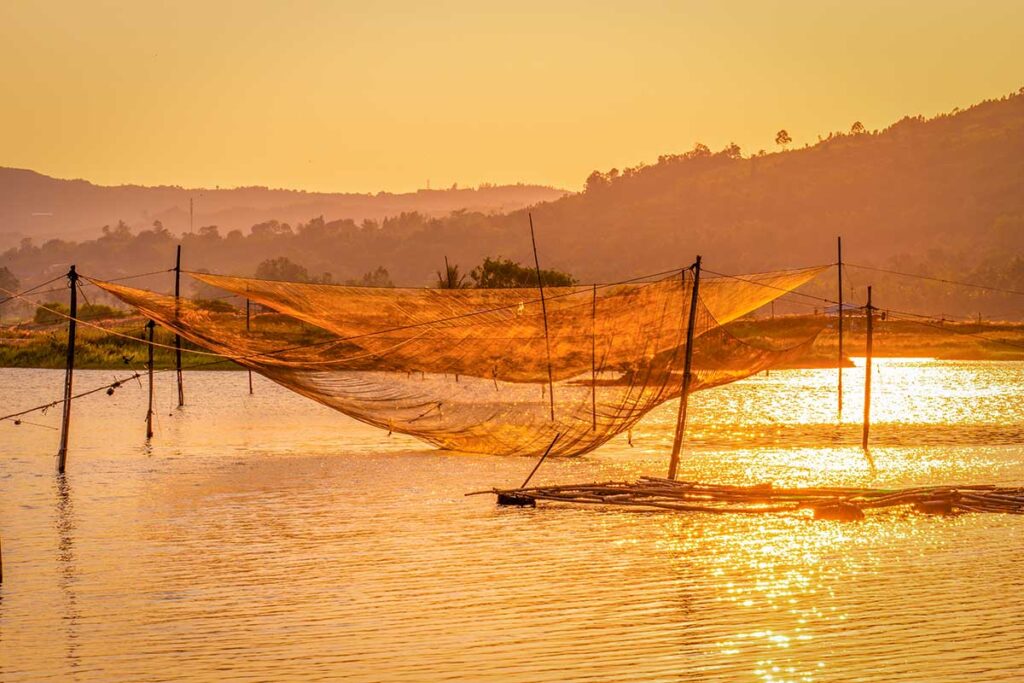
From the middle of the bridge, you get open views over the river and lagoon, with fishing boats, nets, and farmers often in sight. The bamboo railings and the long line of planks make for strong photo compositions. Drones can capture the bridge’s full length beautifully, but check wind conditions and avoid flying directly over people.
10 Facilities on site
There’s no visitor center or tourist setup. At one end, you’ll find a small local drink stall where you can grab a coffee or water with a view of the bridge. Don’t expect more—bring your own supplies, and note that toilets aren’t guaranteed here.
11. Nearby places to combine in one loop
Ong Cop works best as part of a day trip or loop. Combine it with:
- Ganh Da Dia (Da Dia Reef) – striking basalt rock formations.
- O Loan Lagoon – famous for seafood, especially blood cockles.
- Mang Lang Church – one of Vietnam’s oldest churches.
- Hon Yen and Mai Nha Islet – scenic coastal stops.
- Bai Xep & Ganh Ong Hill – sandy beach and viewpoint.
- Ganh Do – a fishing village with colorful scenes.
That way, the bridge becomes a highlight along a broader, very scenic coastal route.
Location & Getting there
Where is Ong Cop Wooden Bridge?
Ong Cop Wooden Bridge lies about 35 kilometers north of Tuy Hoa, the main city and transport hub in Phu Yen. It sits just off National Highway 1, spanning the Binh Ba (also called Phu Ngan) River estuary that flows into O Loan Lagoon. Tuy Hoa is easy to reach by flight, train, or long-distance bus from major cities like Hanoi, Ho Chi Minh City, or Da Nang.
Driving a motorbike
Renting a motorbike is the most flexible and budget-friendly way to explore Phu Yen’s coastline, including Ong Cop. The roads are straightforward, following National Highway 1 with spurs out to beaches and viewpoints. Expect some coastal wind and strong midday sun, so plan breaks and bring water. Officially you need a valid license and International Driving Permit to be properly insured, even though most rental shops don’t ask. Riding a motorbike also lets you combine Ong Cop with Ganh Da Dia, O Loan Lagoon, and other stops in one smooth loop.
Car with driver (private transfer)
If you’re not riding yourself, hiring a private car with driver is the easiest way to include Ong Cop Wooden Bridge in a broader coastal itinerary. Cars can’t drive across the bridge, but that’s not an issue—the main highway runs right past the northern end. You can stop nearby, have a coffee at the small stall by the entrance, and walk onto the bridge at your own pace. A private car works well if you want a comfortable day linking multiple sights, with the convenience of a driver waiting while you explore. It’s usually arranged at a fixed price upfront and avoids the hassle of negotiating with taxis for multiple stops.
Is Ong Cop Wooden Bridge worth visiting?
If you’re wondering whether Ong Cop Wooden Bridge is worth a visit, the answer is yes—with the right mindset. It’s just a bridge, but a pretty unique one, and if you’re already driving the coast it’s absolutely worth stopping for. Even if you’re in a car, you can pull over by the highway, grab a quick coffee at the entrance, and walk across for the experience.
For motorbike riders it’s even better—you really feel the character of the bridge when riding over the creaking planks with water on both sides. It won’t take long, but it’s the kind of stop that makes a road trip through Phu Yen memorable. It’s not a destination on its own, but as part of a loop with places like O Loan Lagoon or Ganh Da Dia, it fits in perfectly.
